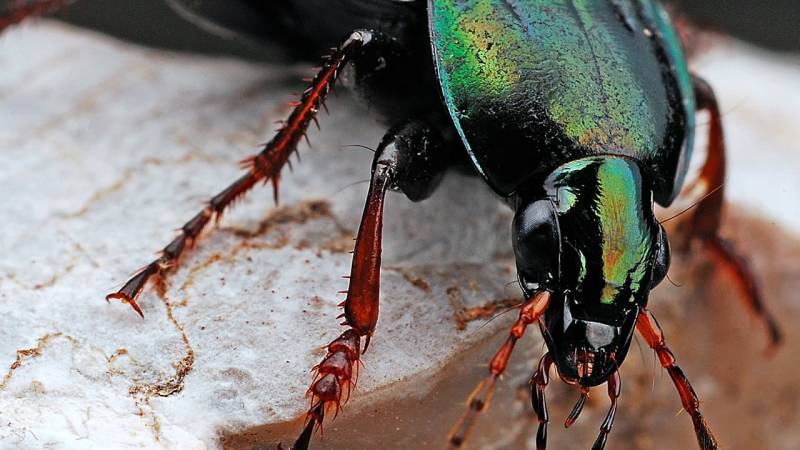
Survival Basics: Eating insects (preparation, catching, cultivation)
👉 The key facts from this guide
- Insects are an excellent source of protein and can serve as food in survival situations. However, you must suppress your aversion to insects.
- There are rules for identifying edible insects. Avoid insects that can sting, are hairy, have bright colors, or can transmit diseases.
- Some of the best edible insects in Europe are crickets, grasshoppers, caterpillars, ants, beetles, and insect larvae.
- To catch insects for consumption, you can look under rocks, tree bark, or leaves. You can also use a pit trap to catch crawling insects.
- It is important to cook or fry insects before eating them to kill any potential parasites. You can roast them over an open fire, boil them in a pot, or fry them in a pan.
- If you have a few insects of the same type, you can breed and propagate them. This way, you have a steady supply of protein-rich food. Grasshoppers are best suited for this purpose.
It's perfectly normal to eat insects.
In Thailand, you can even buy them.
And our ancestors used to eat them, too.
If you're in a survival situation, insects should be your first choice.
Today, you'll learn which insects are edible and how to prepare them.
Is Eating Insects Taboo?
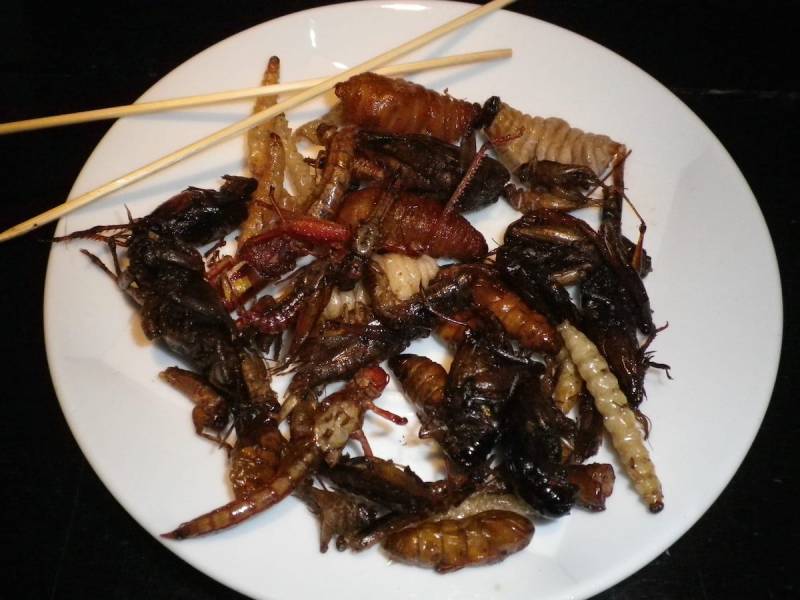
Even after the invention of agriculture, people still enjoyed eating insects.
The ancient Romans ate beetle larvae that were raised on flour and wine.
Even Aristotle wrote about how to raise cicadas for consumption.
Eating insects is completely normal in many cultures, especially in Asia and Africa.
However, in Germany and most other Western countries, eating insects is taboo.
When did we start considering insects "gross"?
One theory is that it happened when agriculture was invented. From that point on, insects were pests and were no longer on the menu.
Below, you can see in the chart which insect species are eaten worldwide (source).
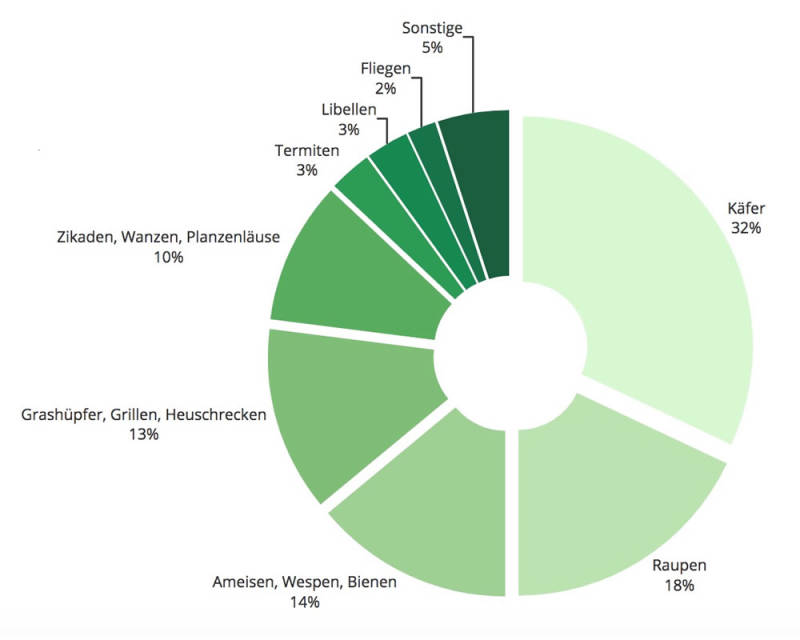
Insects are not gross!
If you find yourself in a real survival situation, you must suppress your repulsion towards insects.
Because insects are an excellent source of protein and will provide you with the necessary energy to survive.
Let me explain it differently: you eat eggs. The egg comes out of a chicken's butt! But you don't find that disgusting, do you?
Take a look at the survival food pyramid and you will see that insects are still relatively easy to catch.
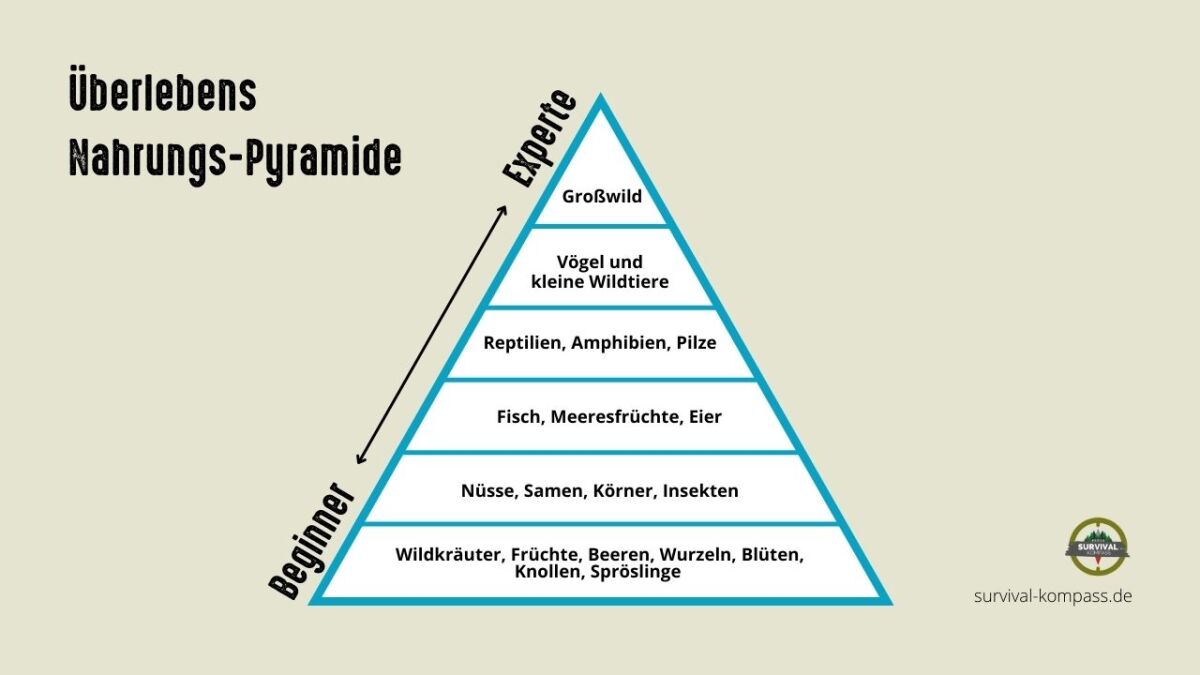
Which insects are edible
There are over 1000 different species of edible insects in Europe.
I don't think you can remember even 100 species.
Therefore, there are rules to identify edible insects.
Stick to these rules and the insect is very likely to be edible.
- Avoid insects that can sting.
- Avoid insects that are hairy.
- Avoid insects that have bright colors.
- Avoid insects that can transmit diseases (mosquitoes, ticks, flies, etc.).
However, there are always exceptions to the rules.
For example, bees can sting, but they are edible and considered quite tasty. Tarantulas are hairy, but are offered as roasted delicacies in many cultures.
Even if an insect contains poison, it is usually destroyed during cooking, making the animal edible.
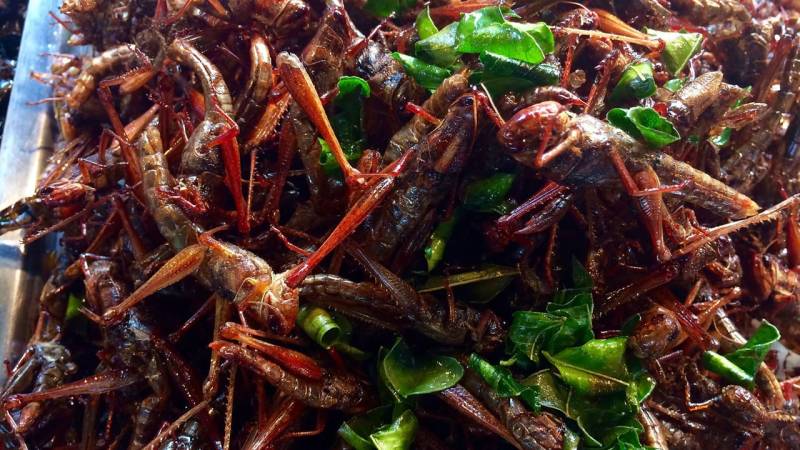
The best edible insects in Europe
These are just some of the many edible insects you can find in Europe. Remember that almost ALL insects are edible.
If you're in a survival situation, turn over the next tree trunk, peel off the next piece of bark, look under the next rock - and eat what you find.
The following insects are good for eating:
- Crickets
- Grasshoppers
- Caterpillars
- Ants
- Beetles
- Insect larvae
- Honeybees
In other countries, termites can also be added to the list.
Attention disclaimer: I am not encouraging you to kill, catch, or eat insects. This article is for theoretical purposes in a survival situation. Most insects in Germany are protected by law. Fines of up to 50,000 euros are imposed for violating the law. Be sure to follow the applicable laws!
How to catch insects for food
Insects can be found everywhere, making them perfect for survival food.
Simply lift an old tree trunk and help yourself to the abundant supply of beetles, larvae, and ants.
Or dig in the ground for beetles and insects.
However, to gather a proper meal, you need other methods.
Pitfall trap
You use a pitfall trap to catch crawling insects, such as beetles.
You can easily build one because you only need a container like a cup or tin can.
- Dig a hole the size of the container.
- Place your container in the ground so that the opening is flush with the ground.
- Place some stones around your container to keep the lid open.
- Put the lid on the container, ideally leaving a gap of 1 to 2 cm.
- Check your trap every 24 hours and empty your container.
Tips:
- Add bait to your trap, such as a piece of sweet fruit.
- Use a funnel and the insects can't escape. The top part of a plastic bottle works well.
Breeding Insects
If you have a few of the same type of insect, you can breed and multiply them.
This way you have a steady supply of protein-rich food.
The best insects for this are grasshoppers. They breed quickly, are strict herbivores and very nutritious.
You only need a large container, some sand and fresh plants to keep grasshoppers.
To breed grasshoppers, you need to add a little sand to the container and keep it slightly moist (otherwise the eggs won't hatch).
Learn more about raising grasshoppers here.
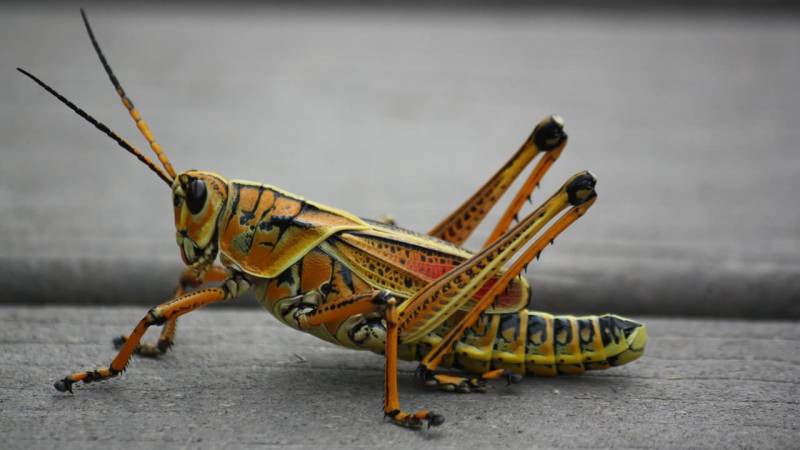
Reading tip: Read my detailed guide on eating grasshoppers here.
Cook Insects Before Eating Them
Only amateurs who have not done their research eat live insects.
Bear Grylls eats raw beetle larvae on television. A bad example.
If you're stomach is upset, you'll vomit and develop diarrhea. Then, because of fluid loss, you will really fight for survival.
Never eat insects without cooking or frying them first!

Would you eat a raw steak? Certainly not.
Just like raw meat can contain bacteria and parasites, insects can too.
When you cook insects, you can eat them without any worries. And they even taste better that way.
Here are some examples of how to cook insects so you can eat them safely:
- Grasshoppers and locusts: Fry or grill them. You can also roast them for a long time and crush them with a mortar. Read my detailed guides on grasshoppers here.
- Slugs: Remove the head and squeeze out the insides. Then, cook or roast them.
- Snails: Pull the snail out of its shell and proceed as with the slugs.
- Ants: Roast them.
- Caterpillars: Boil them for a minute or grill them.
- Mealworms: Cook for one minute or fry in oil/butter.
A word of warning about snails
Be extremely careful when collecting slugs and snails from areas populated by poisonous plants or fungi. Snails, especially slugs, absorb the toxins by eating poisonous plants and fungi.
Depending on the plant, cooking these rubbery creatures will not always break down the toxins to make them safe to eat. Therefore, their stomachs should be emptied for at least 24 hours before cooking.
Since slugs are more likely to eat poisonous plants/fungi than regular snails, people tend to avoid them in favor of their shelled relatives. However, with proper treatment, snails can be safely consumed.
How do insects feed in nature and how does it affect their nutrients?
In nature, insects feed on a variety of different food sources, depending on their species.
These include plants, other insects, carrion, fungi, or even animal excrement. An insect's diet directly affects its nutrient content.
For example, plant-eating insects such as grasshoppers and crickets contain more fiber, while caterpillars that feed on leaves are rich in vitamins and minerals.
Insects that feed on other insects, such as ants, typically have a higher protein content.
To ensure that the insects you consume are nutritious, it is important to catch or breed them in a clean environment and prepare them appropriately.
FAQ: Survival Basics - Eating Insects (Preparation, Catching, Breeding)
Why should you eat insects?
Insects are an excellent source of protein and can serve as a food source in survival situations. They are widely available and easily accessible in many parts of the world. Additionally, they have a low ecological footprint compared to conventional protein sources.
How do you catch insects in the wild?
Insects can often be found under rocks, tree bark, leaves, or near bodies of water. You can also attract them at night by using a light source. Another method is to build traps, such as pitfall traps or adhesive traps.
Which insects are edible?
There is a variety of edible insects, including crickets, grasshoppers, ants, termites, beetles, and caterpillars. Be sure to avoid poisonous or dangerous insects. If in doubt, consult an expert or use an identification book.
How do you prepare insects for consumption?
Insects should be cooked or roasted before consumption to kill any possible parasites. You can roast them over an open fire, boil them in a pot, or even fry them in a pan. Spices and herbs from nature can enhance the flavor.
How do you breed insects at home?
To breed insects at home, you need a suitable environment that meets the needs of the specific insect species. These include temperature, humidity, and food. Learn about the specific requirements of the insect species you choose and set up a breeding enclosure accordingly.
Are insects edible for everyone?
Insects are edible for most people, but there are exceptions. Individuals with shellfish allergies should be cautious as they may also be allergic to insects. Additionally, pregnant women and individuals with weakened immune systems should avoid eating insects to avoid the risk of infections.
How do you store captured or bred insects?
Insects should be stored cool and dry after catching or breeding them. You can store them in an airtight container or in a mesh bag. If you want to store them for longer, you can also freeze or dry them.
Don't Forget: Remove Legs and Wings
If you've ever eaten a whole insect, it was probably terrible for you.
That's because the legs and wings were still attached. These can get caught in your throat and even cause choking.
Be sure to remove the legs and wings, as there is nothing nutritious about them anyway.
And now nothing stands in the way of a delicious insect meal.
Can you imagine eating insects in a survival situation?
Have you ever tried eating insects? Please let us know!


Author of the guide
Martin Gebhardt
Hey, I'm Martin. On my blog, you will learn the basics and numerous details about living in the wild. I think survival, bushcraft and the good life in nature are the keys to happiness. Find me here on Instagram or on YouTube. You can find more about my mission on the About Me page.
Was this guide helpful?
46 people found this guide helpful.
5.00 out of 5 points (46 Ratings)
Comments (0)
This post may contain affiliate links. So if you click on the links and make a purchase, I will receive a small commission at no additional cost to you. Click here, to learn more about it.


